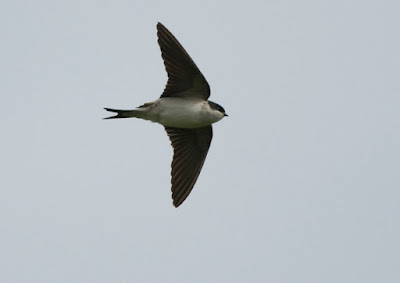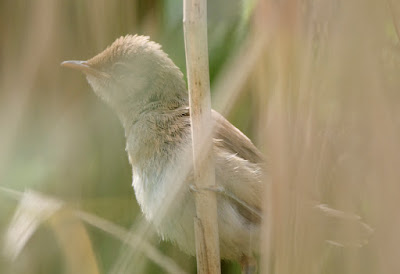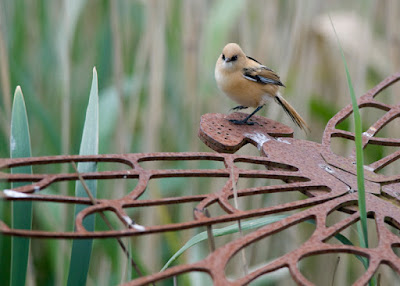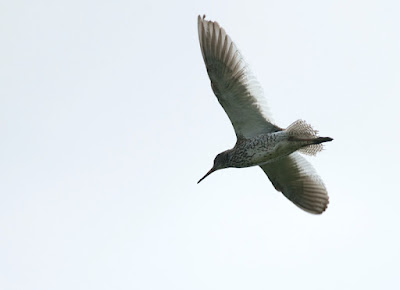In the car park, a cute baby Rabbit grazed, and eyed me anxiously as I took its photo through the car window.
Old Lodge is heathland and pinewood with some pools and a stream in the deep valley that runs down its centre. It is home to various birds that are generally not easy to find in the south-east. In particular, it is well known for its Common Redstarts. Within moments of arrival we had seen several, including fledged young.
Some of the Redstarts. Though numerous they were not very approachable for us - I'd like to have another try, maybe in spring.
We also found a family of Great Spotted Woodpeckers along this upper, wooded path. Here's one of the juveniles.
In a more open area, we spotted a dark, large-looking dragonfly whizzing about, our first of the day. It pitched down in the heather some way off and we went in search, hoping it might be a Golden-ringed (one of the local specialities). Phil spotted the settled dragon first, and said in surprised and slightly awed tones, 'It's a Brilliant Emerald'. My response was an undignified squeal of joy. The next 20 minutes or so involved us edging closer and closer to the resting female dragon which, being teneral, was quite OK about this and let us get close enough for frame-fillers from several angles.
We were both jubilant at enjoying such wonderful view of this dragon, one of the most beautiful odonates I've ever seen. Brilliant Emeralds are, on a national level, one of our rarest dragonflies, occurring only in the south-east of England and the north of Scotland. They occur at Thursley and I had what I put down as a 'probable' there flying over the Moat a couple of years ago, but having seen this indisputable one at close range I'm now a bit doubtful about the Thursley sighting. Though often spoken of in the same breath as Downy Emerald it gives a very different impression to that species.
We carried on the upper path, having fleeting views of Woodlark as well as more Redstarts, and an impossibly high circling Buzzard. Then the path headed down a steep slope, through light woodland where we saw Treecreeper, Bullfinches and Song Thrushes. Then things opened out again and we reached a few small pools on the hillside that looked very Odonata-friendly.
We soon found a fine male Broad-bodied Chaser and several Four-spotted Chasers. Around the margins of the pools were Common Blue and Large Red damsels.
Patrolling the lushest-looking of the little ponds was this superb male Emperor Dragonfly. He was taking occasional breathers in the waterside sedges but most of the time he was zooming up and down over the pool, chasing the chasers. Now and then a female would show up, whereupon he rushed up to her and the pair would have a brief, frantic mid-air copulation, and then she would zoom off again and he would resume his patrolling/resting schedule.
I decided to try to catch the male in flight, setting myself up for 40 minutes of sheer frustration. On what I swore would be my last try I managed a few frames of actual dragonfly but didn't think they were any good - was pleasantly surprised to find this one when I got home.
Emperors are not given to hang on the spot, like Migrant Hawkers and Downy Emeralds sometimes do. However, this male did slow down a bit when approaching the area where he liked to perch.
Leaving the dragons behind, we headed down into the valley and the stream, which was devoid of dragons. The path then climbed the hillside to the far edge of the reserve.
The climb was steep, and it was a bit of a relief to pause now and then and photograph something - in this case one of the many orchids (I think Common Spotted) growing among the heather.
We also stopped to have a look at a Tree Pipit which was singing exuberantly away from a very high treetop. We waited a while and were rewarded with a fantastic song-flight, the little bird parachuting directly overhead while throwing out an even more upbeat version of its song.
A third pause and then detour came when we saw a Cuckoo perched in a dead tree, and as we were thinking about trying to get closer, it flew down to ground level. We stalked up to where we thought it had landed but managed to flush it without ever seeing it on the deck.
The Cuckoo detour did produce extra interest in the form of this mad little fungus (we think it's a fungus, anyway), sprouting out of a well-rotted tree stump. Any thoughts on ID most welcome...
The path along the far side didn't produce very much - another Tree Pipit or two, a Siskin, a Stonechat family. Then we were looping back towards the car park.
The last stretch of path before we completed the circuit produced one of the day's few butterflies, this Small Heath. We also saw Meadow Browns (first of the year for me), and a couple of fast-moving Painted Ladies and Small Torties.
We had a sit-down under a tree in an area that seemed quite busy with birdlife, and this young Stonechat came along and posed on a Foxglove. Then a small party of Woodlarks went overhead, and landed not far off, so we attempted to approach them.
The Woodlarks were foraging on bare ground near the road but resolutely stayed out of camera reach. Here is a record shot, which is at least recognisable as a Woodlark. A nicely pink-chested Linnet sang nearby.
And I have no further photos, your honour. We did go back to the pools for a little while but I could not get anywhere near a photo of the Emperor. It was a great day all in, and I definitely hope to return to this lovely reserve.












































































